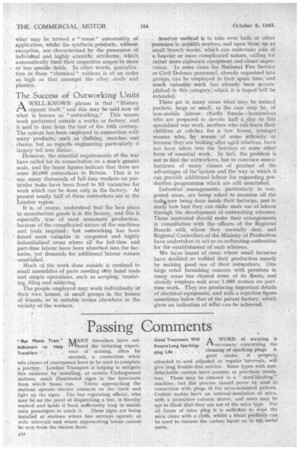The Success of Outworking Units' A WELL-KNOWNphrase is that "History repeats
Page 16

If you've noticed an error in this article please click here to report it so we can fix it.
itself," and this may be said now of what is known as "outworking." This means Work performed outside a works or factory, and is said to date from the end of the 18th century. The system has been employed in connection with many products, such as clothing, matches and chains, but as regards engineering particularly it largely fell into disuse: However, the essential requirements of the war have called for its resuscitation on a much greater scale, and the latest figures -indicate that there are some 20,000 outworkers in Britain. That is to say, many thousands of full-time workers on particular tasks have been freed to fill vacancies for work which can be done, only in the factory. At presenf nearly half of these outworkers are in the London region.
It is, of course, understood that the best place to manufacture goods is in the factory, and this is especially true of most armament production, because of the complicated nature of the machines and tools required ; but outworking has been found most valuable in congested and highly induseialized areas where all the full-time and part-time labour have been absorbed into the factories, yet demands for additional "labour remain unsatisfied.
Much of the work done outside is confined to .small assemblies of parts needing ably hand tools and simple operations, such as scraping, insulating, filing and soldering.'
The people employed may work individually irr their own homes, in small groups in the homes of friends, or in suitable rooms elsewhere in the vicinity of the workers. Another method is to take Over halls or other premises in suitable centres,. and open these up as small branch works, which can undertake jobs of a heavier or more complicated nature, calling for rather more elaborate equipment and closer supervision. 'In some cases the National Fire Service or Civil Defence personnel, already organized, into groups, can be employed in their spare time, and much valuable work has already been accomplished in this category, which it is hoped -will be extended.
There are in many areas what may be termed pockets, large or small, as the case may be, of non-mobile labour,' chiefly 'female—housewives who are prepared to devote half a .day to this specialized war work, mothers who can leave their children at crèches for a few hours, younger. women who, by reason of some infirmity or because they are looking after aged relatives, have not been taken into the Services or some other form of essential work. In fact, the problem is not to find the outworkers, but to convince manufacturers of many classes of product of the advantages of the-system and the way in which it can provide additional labour for expanding production programmes which are still unsatisfied.
Industrial' managements, particularly in congested areas, are being asked to examine all the task4now being done inside their factories, and to study how best they can make more use of -labour through the development of outworking schemes. Those interested should make their arrangements in consultation with theofficers of the Regional Boards with whom they normally deal, and -Regional Controllers of the Ministry of Production have undertaken to act as co-ordinating authorities for the establishment of such schemes.
We have learnt of cases where small factories have doubled or trebled their production merely by making good use of their outworkers. One large retail furnishing concern with premises in many areas has cleared some of its floors, and already employs well over 1,000 women on parttime work. They are producing important details of electrical equipment, and with a rejection figure sometimes below that of the parent factory, which gives an indication of wliat can be achieved.




















































